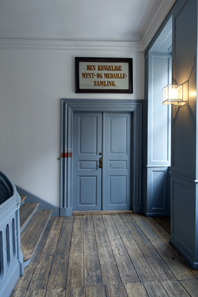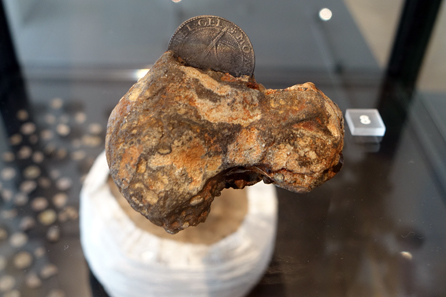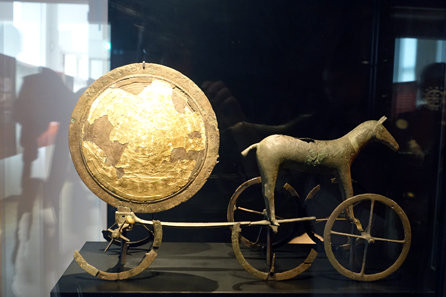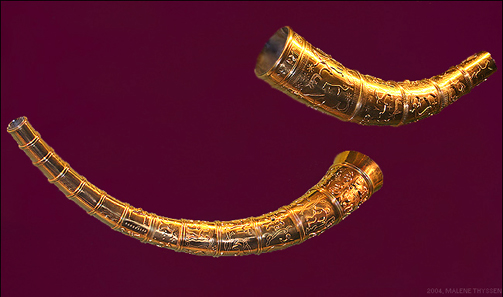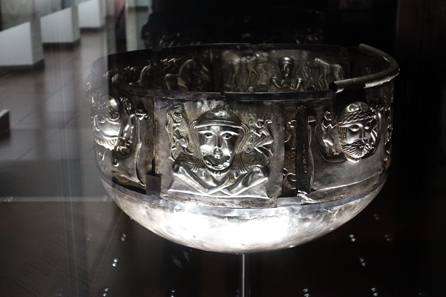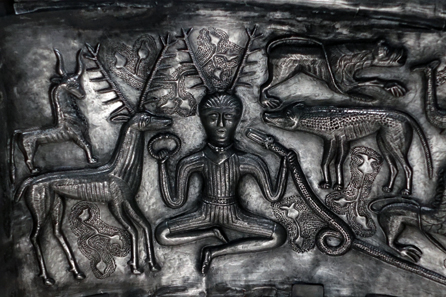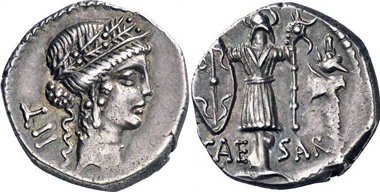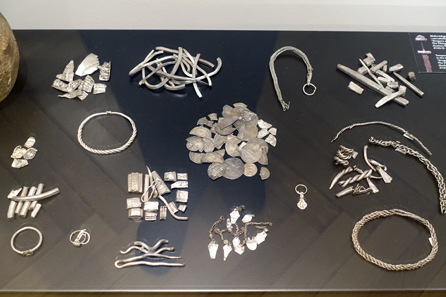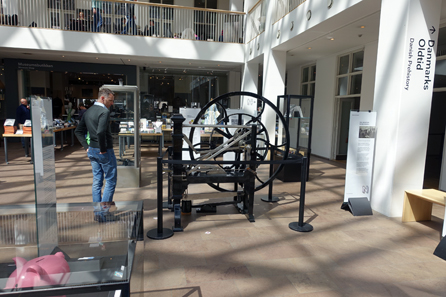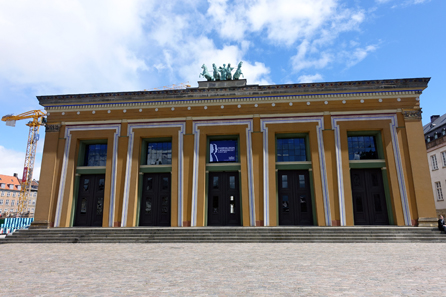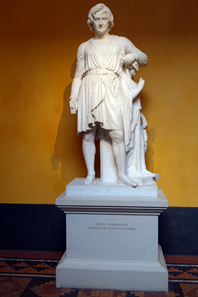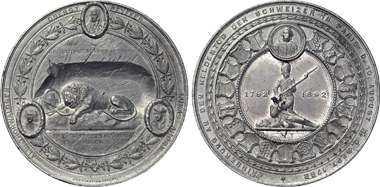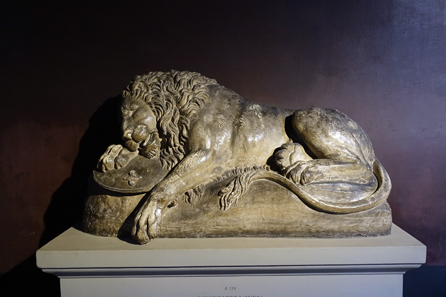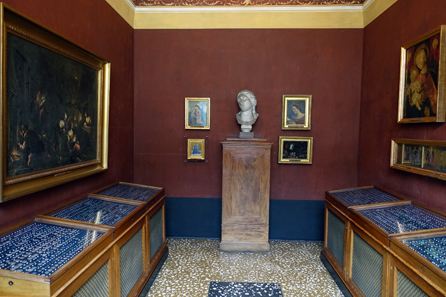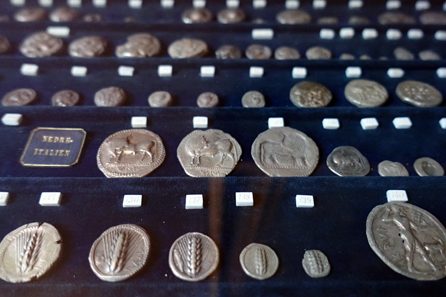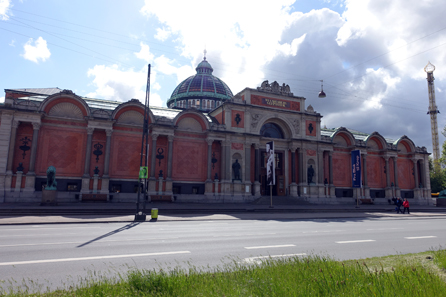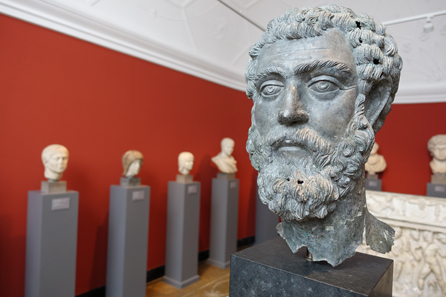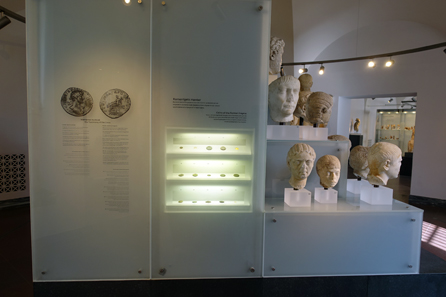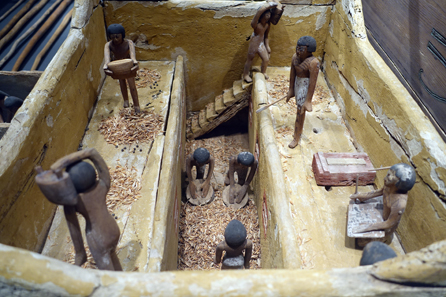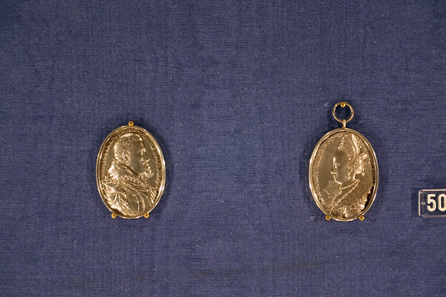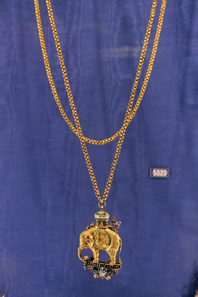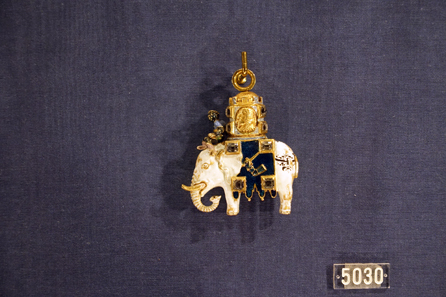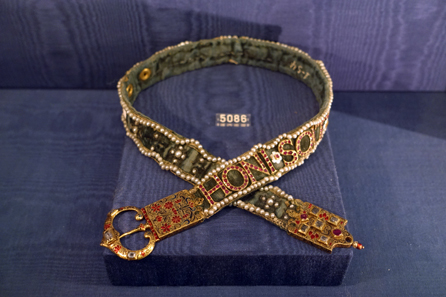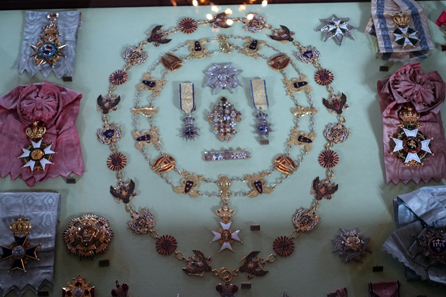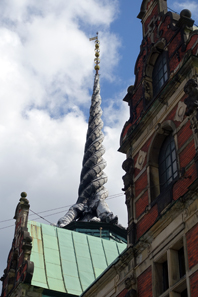by Ursula Kampmann
translated by Annika Backe
June 18, 2015 – Copenhagen is much more than the Little Mermaid and Tivoli. It is a city which match up to every metropolis throughout the world thanks to its museums. The National Museum of Denmark houses treasures like the Trundholm Sun Chariot and the enigmatic Gundestrup Cauldron, the Thorvaldsen Museum as the world’s first museum devoted to one single artist, and the Ny Carlsberg Glyptotek with its outstanding portrait gallery of Roman emperors – in their permanent exhibitions, they all display coins, medals, and orders. Those are not the only places in Copenhagen where something interesting, in terms of numismatics and economic history, can be encountered though.
Today, we visit the museums of Copenhagen to search for numismatic traces.
Permanent exhibition of the Coin Cabinet of Copenhagen – unfortunately, closed at the moment. Photo: UK.
Naturally, we visit the National Museum of Denmark first of all, which is worth a visit not only because of its absolutely gorgeous coin collection that has been assembled over the course of centuries. This is where the Danish coin and hoard finds are kept, many of them on display.
A Dutch thaler from the early 17th century in a stone, presumably intended as foundation sacrifice. Discovered by Stanley Andreasen, Jutland, Bulbjerg. Photo: UK.
These finds are given the best place possible, with a good lighting and proper descriptions. Every visitor heading for the permanent exhibition on the pre-history of Denmark passes the new exhibition hall with the latest coin finds. In Denmark, searching for coins with a metal detector is perfectly legal as long as discovered objects are reported. About 3,000 pre-1537 coins enter the cabinet every year that way, while specimens from later times are usually given back to their finders, unless the material is of particular historical importance or constitute a hoard find. The researchers have to draw that line for they would be flooded with coins otherwise. If the museum withholds an object, the finder gets a fair reward, exempted from tax, in return and his name is stated properly everywhere. How successful the Danish Coin Cabinet has been with that policy can be seen in the exhibition.
Hoard find of amber, around 1400 BC, discovered in North Jutland together with two bronze collars. Photo: UK.
That some hoard finds predate the introduction of coins is illustrated by the permanent exhibition spanning the chronological range from the Paleolithic Era to the Viking Age. The visitor marvels at huge hoard finds consisting of flint knives, bronze axes and bars as well as amber.
Trundholm Sun Chariot. Photo: UK.
Of course, those are not the great crowd pullers. The Trundholm Sun Chariot falls into a different category. It dates to the late Bronze Age and was discovered in 1902, when a moor was ploughed. It is thought to depict the sun being drawn through the sky. With its decoration it may have functioned as a calendar.
Copies of the Golden Horns of Gallehus. Photo: Malene Thyssen / Wikipedia.
Mere copies are left of the Golden Horns of Gallehus, due to historical events. Those magnificent items, made in the early 5th century AD, were found as early as 1639 or 1734, respectively. At that time, they were kept in the Royal Art Chamber at Christiansborg from where Niels Heidenreich heisted them on May 4, 1802. Heidenreich had been well-known to the authorities. As a convicted counterfeiter, he had been sentenced to death in 1788, but was pardoned in 1790, to imprisonment for life. When in jail, he worked at the Royal Art Chamber at Christiansborg. After his release, he continued working there and hence could easily make false keys. One night, he broke into the Art Chamber and took the heavy golden horns. He melted them down in his kitchen to make counterfeit coins which he then offered to colleagues as ‘Indian antiques’. With the bounty on Heidenreich’s head amounting to 1,000 thaler, those colleagues were careful and thus reported the thief to the police. Heidenreich was arrested and, after confessing, was sentenced to imprisonment for many years. In 1840, he was released and brought to an institution for forced labor where he died four years later.
Fortunately, many drawings had been made of the horns before they were stolen and so pretty accurate replicas could be made. By the way, those replicas are much sought-after, too, and were stolen from the Jelling Museum in 2007.
Gundestrup Cauldron. Photo: UK.
Even more famous is the Gundestrup Cauldron, discovered in a moor in Jutland in 1891. Most likely it was produced somewhere in the South, though the exact place is a matter in dispute. This artifact sheds light on Celtic religion and depicts objects that are known from Celtic coinage and from Roman coins referring to victories over the Celts, respectively.
Gundestrup Cauldron / detail: Antlered god holding a torque in his hand. Photo: UK.
Presumably the most famous depiction is the one of an antlered god, often addressed as Cernunnos. The torque in his right hand is clearly visible …
Vindelici. Rainbow cups. Rev. Six pellets within torque. Auction Gorny & Mosch 228 (2015), 2.
… as we know it from rainbow cups, for instance.
Gundestrup Cauldron / detail: Warriors playing the carnyx.
Another element is the trumpets blown by warriors.
C. Iulius Caesar. Denarius, 48-47. Rev. Trophy with Gallic trumpet. Auction Gorny & Mosch 176 (2009), 1972.
The elongated musical instruments with the animal’s head we know from the denarii of Caesar, too.
Hacksilver hoard find. Photo: UK.
Back to the hoard finds: the Early Medieval section reserves an entire room for hacksilver hoard finds, hence hoards that comprise silver as raw material. Here you can see one of the largest hacksilver hoards. It dates to the 10th century, was found in Himmelland and has a total weight of 5 kg.
Hoard find of hacksilver. Photo: UK.
This find from Bornholm dates to the same period. The great number of Islamic dirhams from the Near East is particularly interesting, evidencing the far-reaching trade links of the Vikings.
The largest Danish coin find ever. Photo: UK.
That is not to say that the other departments of the museum have nothing numismatic to offer at all. Here you see the Kirial Hoard which was buried around 1365. With its 81,000 (sic!) coins from Northern Germany, England and France, it is the largest hoard every discovered in Denmark.
Special exhibition of the Coin Cabinet in the National Museum of Denmark. Photo: UK.
In addition, the colleagues from the Coin Cabinet had organized a special exhibition, in honor of the participants of the DAMIN meeting, with an Uhlhorn coining press as centerpiece.
Thorvaldsen Museum.
Less than 500 meters from the National Museum of Denmark, the Thorvaldsen Museum is located, the world’s first museum devoted to one single artist.
Bertel Thorvaldsen, self-portrait. Photo: UK.
Bertel Thorvaldsen (1770-1844) is one of the most celebrated of all neoclassical sculptors, creator of countless 19th century statues, some of which are likewise depicted on medals.
Medal commemorating the fallen in the resistance against the French revolutionaries. Av. Lion of Lucerne Monument. Photo: UK.
A case in point is the lion …
Plaster cast for the Lion of Lucerne Monument. Photo: UK.
… for the Lion of Lucerne Monument.
Coin collection of Bertel Thorvaldsen. Photo: UK.
It goes without saying that Thorvaldsen possessed a high-caliber coin collection, on display on the upper floors. It consisted of 2,794 Greek coins and 673 Roman-Byzantine specimens that all became part of the museum. Roughly 1,000 coins were auctioned in Copenhagen as early as 1866. Much of the remaining material is still exhibited in the museum.
Coin collection of Bertel Thorvaldsen. Photo: UK.
As is his extensive collection of Greek, Roman and Egyptian antiquities. The sculptor further assembled a collection of plaster casts of famous ancient statues which served as an inspiration for his own creations.
Wallet of Bertel Thorvaldsen. Photo: UK.
Thorvaldsen was one of the best-paid artists of his days. And so he had a bulging wallet with him when he came to the Royal Theater the night he was to collapse and die on his seat.
Ny Carlsberg Glyptotek. Photo: UK.
If you haven’t seen enough coins by now, you should visit the Ny Carlsberg Glyptotek. It serves as living proof of the fact that drinking beer promotes culture: The exhibits have been collected by Carl Jacobsen, founder of the Danish Carlsberg Brewery which, as Carlsberg Group, is one of the world’s biggest brewing companies.
Portrait of Agrippina the Younger, wife of Claudius, mother of Nero. Photo: UK.
It is amazing to see what Carlsberg has assembled. The visitor stands in awe of his collection of portraits of Roman emperors and empresses.
Bronze portrait of Septimius Severus. Photo: UK.
The first century is particularly well-represented, but the eras of the Severans and the Barracks Emperors offer some high-quality portraits as well.
Roman Portrait Room. Photo: UK.
It hardly deserves mention that such a museum houses coins, too.
Egyptian tomb model of a granary, c. 2000 BC. Photo: UK.
What we see here is a testimony of particular relevance for economic history. This tomb model, made around 2000 BC, is a reflection of Egyptian every-day life at that time. It is clear to see how important writing was in Egypt back then. No account keeping, no stockpiling. This model therefore not only includes the men who carry the grain sacks to the granary and those who mill the flour and bring it to the bakery, but the writer as well who, with his quill, thoroughly records how much grain is arriving at the granary and how much is leaving it.
Rosenborg Castle. Photo: UK.
It is hard to believe that this still isn’t the end of the numismatic road! Rosenborg Castle, where the Royal Coin Collection used to be stored, houses the Royal Treasury until the present day.
Gnadenpfennige. Photo: UK.
Thus, the gentle visitor does not only see numerous gnadenpfennige …
Example of an Order of the Elephant, bestowed prior to 1693. Photo: UK.
… but likewise orders which are almost impossible to come by in auctions, as the Danish Order of the Elephant, founded by King Christian I in 1462, for example.
Order of the Elephant after 1693. Photo: UK.
In 1693, the statues of the order were enacted, stating that, firstly, the small elephant was to be made of white enamel henceforth and, secondly, the order was to have only one class consisting of 30 knights, on which the Order of the Dannebrog must have already been bestowed.
Order of the Dannebrog. Photo: UK.
Of course this order is exhibited in the treasury as well. Legend has it that the Order of the Dannbrog was founded as early as 1219, when Valdemar II fought against the Estonians. Just as the Order of the Elephant, the Order of the Dannbrog got its statute as late as 1693.
Order of the Garter. Photo: UK.
The British Order of the Garter did not need any legends to rank as the oldest order of historical significance, being founded in 1348 during the Hundred Years’ War. It was founded in times of war, with the aim of establishing an ever closer connection between the knights and their king.
Order of the Garter. Photo: UK.
The order proper, Saint George fighting the dragon, can be encountered in many variants in the Danish treasury.
Order. Photo: UK.
Those are by no means the only orders on display at Rosenborg Castle. On the contrary, orders and medals can be found at every turn. Some specimens of the latter category, however, have been cleansed and thus look rather appalling now.
The Old Stock Exchange. Photo: UK.
We could point to and talk about a lot more facts and places that are interesting from a numismatic, economic and historical perspective! A good example would be the Old Stock Exchange, the oldest of its kind in Denmark. It was built between 1619 and 1640 by Christian IV who wanted to turn Copenhagen into a commercial hub, following the example set by the city of Amsterdam. Hardly surprising, therefore, that the edifice resembles Renaissance buildings of that time in the Netherlands. It housed the Danish stock-market until 1974!
Dragon Spire. Photo: UK.
In 2003, the Dragon Spire was chosen as motif for the second issue of the series of Danish 20-krone commemorative coins. A second tower in Copenhagen graces another coin of this series: the Copenhagen City Hall Tower.
National Bank. Photo: UK.
You may also pay the National Bank a visit, and so on and so forth. Copenhagen offers incredibly much, not only in regards to numismatics.
A very good overview of Copenhagen’s numerous sites of interest is provided on the website of the Copenhagen Visitor Service.
You can take a virtual tour around the National Museum of Denmark here.
The website of the Thorvaldsen Museum gives you an insight into his work.
The mythological art of Bertel Thorvaldsen is highlighted in this movie.
Naturally, the Ny Carlsberg Glyptotek has its own website.
As has Rosenborg Castle.
You may even go on a virtual tour around Rosenborg Castle.
All Danish tower coins can be found here.




